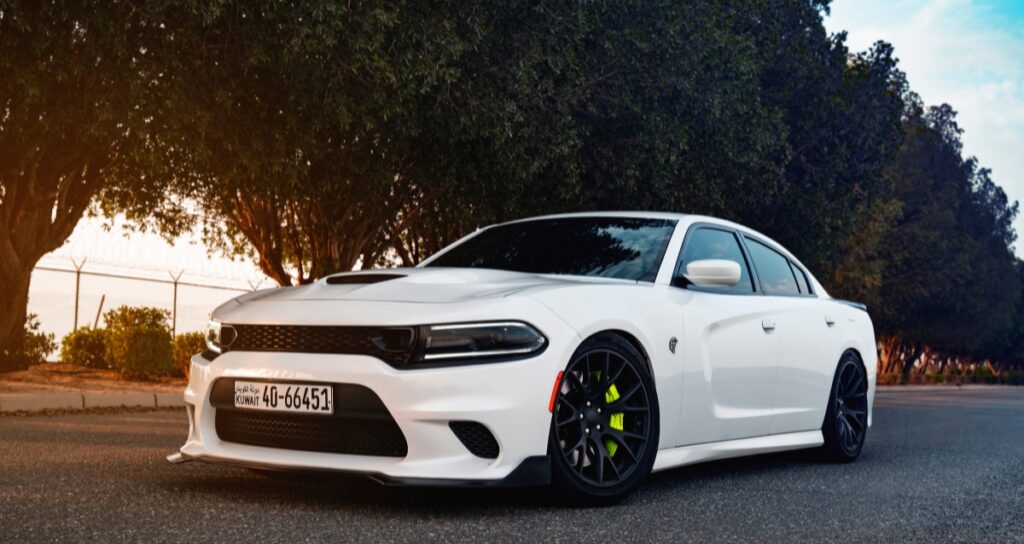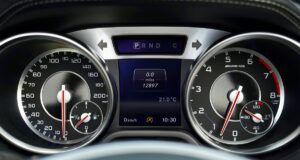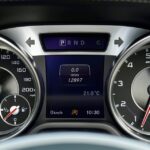What is a hybrid car?
A hybrid car uses a combination of a usual combustion engine – be that petrol or diesel – and an electric motor and batteries. Where the variation lies between different types of hybrid vehicles is in the size of the electric motor and batteries.
A larger electric motor might make a hybrid drive a little bit more like a fully electric vehicle, while a bigger battery can allow a hybrid vehicle to travel for longer distances using only electric power alone, rather than using the engine. The benefit of this? You’ll use less fuel and the car will be cheaper to run as a result. Win-win!
The history of hybrid cars
How long have hybrid cars been around?
The very first hybrid vehicles started to emerge in the very late 1800s, with the London Electric Cab Company using a car called the Bersey Cab. Designed by Walter Bersey, it featured a very small motor and battery, but could still manage up to 50 miles between charges.
Dr Ferdinand Porsche also developed a hybrid – called the Lohner-Porsche Mixte Hybrid – that could do 40 miles on electric power alone. Not bad for 1898!
In more modern history, 1973 was the year that Volkswagen created the ‘Taxi’, which could switch between petrol and electric, while in 1992 Volvo made the Environmental Concept Car or ECC – which operated with a hybrid electric and gas turbine. Things really shifted up a gear in 1997, however, with the introduction of the Toyota Prius. Though it would take until the year 2000 for the Prius to be launched in Europe, its impact was immediate and it soon became the go-to hybrid car.
When was the first hybrid car built?
The date when the first hybrid car was first built is widely disputed, with many petrol-electric taxis being developed across the world. However, the Lohner-Porsche Mixte Hybrid is widely thought to be one of the very earliest versions of what we’ve come to call a hybrid vehicle today.
How do hybrid cars work?
All hybrids use a combination of a traditional combustion engine (petrol or diesel) and an electric motor and batteries. For example, the new Toyota Yaris uses a 1.5-litre petrol engine which is then combined with an electric motor and a compact battery. Regular, non-plug-in hybrid cars use a blend of electric and combustion power to achieve better fuel efficiency. So imagine that the electric motor is being used to take some of the ‘strain’ away from the petrol engine and, in doing so, means that the petrol engine doesn’t have to work quite as hard as it would do on its own. Because of this, the engine won’t use as much fuel.
Regular hybrids can’t drive for very long on electric power alone. In smaller hybrids, like the Yaris, you’ll be able to drive on electric power at very low speeds – such as when parking – or when moving in traffic.
The petrol engine is then used to keep the battery topped up, without any need for plugging in. But since these cars only have relatively small batteries, it doesn’t take much to keep them charged, but a by-product of this is that they don’t hold enough energy to power the car on electric-only power for very long.
But what is the point of all this and what is the benefit, you ask? As we mentioned, an electric motor can help to take some of the load away from a petrol engine. In doing so, it becomes more efficient, reducing fuel consumption and improving CO2 emissions. So, if you’re keen to lower your fuel bills, then a hybrid could be a good option.
What are the different types of hybrid vehicles?
If you’re interested in buying a hybrid car, thankfully there are now a number of options available, and we’ve got plenty to choose from here at Motors. But first things first, what are mild-hybrid cars? These use a compact battery and a small starter/generator (similar to your car’s starter motor) to provide a small amount of assistance. These mild-hybrids can’t really drive on electric power alone, but instead use the battery’s energy to power aspects such as the air conditioning to help reduce the load on the engine.
Then, there are regular hybrids. You might have heard these referred to as ‘self-charging’, but this is more like a marketing term. In truth, any hybrid that doesn’t have a plug-in option could be referred to as a ‘regular hybrid’ – excluding smaller mild-hybrids, of course. A regular hybrid will have a larger battery than a mild hybrid and will feature a compact electric motor too. They can travel in fully-electric mode for short periods of time and at slow speeds, while the petrol or diesel engine feeds energy into the battery to help keep it topped up. Cars with hybrid technology include the previously mentioned Toyota Yaris, and Suzuki’s Vitara.
Finally, we have plug-in hybrids. So how does a plug-in hybrid work?
As you might expect, these have the option to plug them in to top up the battery. Because of this, they’re fitted with larger batteries which can allow for more electric range. In fact, some of the latest plug-in hybrids – often known as PHEVS – can drive for up to 50 miles on electric power alone, and at speeds of up to 80mph, too.
How do petrol hybrid cars work?
Petrol hybrid cars work by blending a traditional petrol engine with an electric motor and batteries. It’s more common to see petrol-powered hybrids, but all ‘regular’ hybrids use this motor as a primary power source. As we’ve mentioned, plug-in hybrids are able to travel using electric power for much longer. In a regular hybrid, there’s a circle of energy, with engine power being sent to the batteries, which then powers the electric motor and blends with the engine to power the wheels.
It’s worth noting though that some recent hybrid cars have shaken up this traditional method. The new Honda Jazz, for instance, still uses a petrol engine, but this isn’t used to power the wheels directly. Instead, the petrol engine sends its power directly to the battery, which then powers the electric motors to drive the wheels. In doing so, the petrol engine acts more like a ‘generator’ and can operate at its most efficient level at all times. A by-product of this setup is that it drives more like a fully electric vehicle than a standard petrol or diesel car.
Are there any diesel hybrid cars?
There are some diesel hybrid cars, but they aren’t very common. They’re predominantly made by Mercedes, with cars like the E300de. However, diesel hybrids offer a really good compromise as once their battery power has run out, you’re still left with a very efficient engine to rely on. So while many hybrids do tend to be less efficient when doing a lot of motorway miles, hybrid diesels are a more fuel-friendly option if you’re on a budget or are looking to cut down your fuel costs. They’re mostly plug-in hybrids, too.
What is a plug-in hybrid?
A plug-in hybrid gives you the ability to charge up via – you guessed it – a plug. As well as at home – where you’ll be best to install a charging point to make things easy – you’ll be able to top up using public chargers, just the same as an electric car. However, when compared to a fully electric car, plug-in hybrids can’t charge at the same ‘speeds’, so there’s not much point in using high-powered chargers that are more expensive to use.
Our top tip? Although you can use your car’s petrol or diesel engine to charge up the batteries, doing so on plug-in hybrids can quickly send fuel economy skyrocketing – so it’s always more efficient to charge them up via the plug.
Plug-in hybrids will also bring very low CO2 emissions, while you might see some manufacturers claiming really impressive fuel economy figures – well over 150mpg – but this relies entirely on the cars being fully topped up with electricity. If a plug-in hybrid is driven without any charge in it for long periods it will, more often than not, return fuel economy figures that aren’t quite as good. As with fully electric cars, plug-in hybrids rely on you having access to a charging point – so if you haven’t got one nearby or can’t fit one to your home, you may be better suited to a ‘regular’ hybrid.
What is the difference between a hybrid and a ‘self charging’ hybrid?
There’s no difference between a hybrid and a ‘self-charging’ hybrid. Essentially, all non-plug-in hybrid cars are ‘self-charging’, because they send power from the petrol engine to keep the electric battery topped up. It’s just a term used by many car companies to describe their hybrid engines. But remember, regular hybrids can’t deliver the same fuel economy or electric-only running ability as a plug-in hybrid, which have larger batteries and motors.
What is stop-start technology?
You might’ve encountered stop-start technology on your car already. When you come to a halt and put the car into neutral, the car will automatically shut off the engine when you raise the clutch. Dip the clutch and select a gear, and the engine will start up again. For cars with automatic gearboxes, all of this will happen automatically, with the engine cutting out when you slow to a stop. Some cars are able to shut off the engine when coasting at motorway speeds too. Known as ‘sailing’, this can seriously improve fuel economy, particularly over long journeys.
Cars fitted with stop-start technology get more heavy-duty components so that they don’t wear out. After all, stopping and starting the car frequently does put more stress on the engine, but these upgrade components mean that they’ll last just as long as on a car without stop-start technology. Those mild-hybrid cars that we talked about earlier use their electrical charge to start the car each time, too.
But what’s the benefit? Well, its primary advantage is that it helps reduce emissions. If you’re sitting in crawling traffic on your way to work, then switching the engine off stops it from emitting anything. Plus, at the same time, your car isn’t using any fuel – so it does have a positive effect on fuel economy.
On all cars there’s the option to switch stop-start off, but your car is definitely at its most efficient when it’s kept on.
How do you charge the battery in a hybrid car?
As we’ve already touched upon, how your hybrid car charges up its batteries depends on what type of hybrid you’re looking at. A regular hybrid will draw power from the petrol energy to keep the battery topped up – and none of this requires any input from the driver.
Plug-in hybrids, meanwhile, are primarily best charged via the plug at home. This will allow you to charge the batteries more quickly and without requiring the engine’s help.
Many hybrids and plug-in hybrids use something called ‘regenerative braking’, too. This is a clever way of harvesting the energy that would otherwise be lost during slowing down or braking. So when you’re slowing down, the electric motor can effectively be put into reverse and, instead of sending power out to the wheels or engine, it’ll send it back into the battery. This system is more aggressive in some cars than others. For example, in some hybrids, when you lift off the accelerator the car will actively start to slow down – almost like you’ve applied the brake – and this is it harvesting energy. This setup is used in nearly all fully electric vehicles, too.
What are hybrid batteries made of?
Hybrid batteries are made up of a variety of materials. Most hybrids use modern lithium-ion batteries, which have been adopted because they provide a lot of power for how much they weigh, but they’re also better at staying at a level temperature. Electric vehicles also use lithium-ion batteries, but they’re used in smartphones and laptops, too. Lithium-ion battery technology has radically changed how plug-in hybrid and electric vehicles work, because they deliver a lot of power relative to their size. Smaller batteries means less weight, which makes a car more efficient.
Some hybrids also use nickel-metal hydride batteries. These are able to deliver a good amount of power relative to their size – though not as good as lithium-ion batteries.
How long do hybrid batteries last?
Hybrid batteries have been engineered to last a long time. The majority of manufacturers offer very extensive warranties on their batteries, with Toyota, for example, covering their hybrids with a five-year or 100,000-kilometre warranty, but they’ve been engineered to last the lifetime of the vehicle.
However, if you take a look at our used car pages, you’ll see that many hybrids have managed well over 200,000 miles and still make for a great, low-cost option if you’re looking into hybrid ownership.
Is a hybrid car right for me?
For many people, a regular hybrid will be a great option. Because of that added electrical assistance, they’re often more efficient than conventional petrol or diesel cars. Though they often cost a little more than a non-hybrid car, a regular hybrid will definitely have a positive impact on your fuel bills.
Plug-in hybrids can really help financially. Particularly if you’re making frequent short journeys – like the school run or trips to the supermarket – since a plug-in hybrid will really make a difference to fuel bills, simply because you’ll be able to travel on fully-electric power for the majority of your journey. For commuters with an average-length drive, there are also benefits. This is even more true if you’ve got any charging points at your workplace, as you’ll be able to charge up while you’re at the office and then return home with a full battery.
What are the disadvantages of a hybrid car?
Though hybrid vehicles do carry many advantages, there are some disadvantages that accompany them. The primary downside is price. Given that hybrid vehicles utilise additional batteries and electric motors, they often cost more than a typical petrol or diesel-powered car. You then have to weigh this against the potential fuel savings, mind you, but that initial cost could prove to be a barrier for many drivers.
With plug-in hybrid vehicles, their disadvantage lies with charging. If you don’t have local, low-cost and reliable charging to use, then running a plug-in hybrid simply won’t make sense. They’re at their most efficient when fully charged up, so the ideal situation is to have a home charger that can keep them topped up whenever they’re parked up at home. Even with the current high energy prices, plugging in at home is still the most cost-efficient way of keeping a plug-in hybrid charged. So if you’re not able to charge at home or extremely nearby, then using a plug-in hybrid won’t be the most efficient – nor the cheapest – option.
If you’re wondering when hybrid cars will be banned, the government is implementing a ban on the sale of all new petrol and diesel cars from 2030. Having said this, new hybrid vehicles will still be available to purchase up until 2035. It’s designed to introduce a more phased approach to fully electric vehicles.
Do hybrid cars save money?
As we’ve mentioned, hybrid vehicles definitely have the potential to save you money. Even mild hybrids have a positive effect on a car’s fuel economy, while regular hybrids will bring improved fuel consumption figures. Plus, thanks to lower emissions, you’ll pay less in tax with most hybrids, and the savings are even greater in this area when it comes to super-clean plug-in hybrids.
It does boil down to the type of driving you’re doing, however – high-mileage, long-distance drivers, for example, simply won’t see the benefit.
Is it worth buying a Plug-in Hybrid Electric Vehicle? (PHEV)
A plug-in hybrid can definitely make for a smart choice for many drivers. If you have a shorter commute or daily drive, then a plug-in hybrid’s electric ability will mean that your fuel usage will drop considerably. The issue, of course, comes down to price. Many plug-in hybrids will cost more than a conventional petrol or diesel. However, since the technology has been around for a little longer now, there is a good variety of plug-in hybrid vehicles available on the used market, which does help to bring down this initial cost further.
Hybrid ownership can be a great stepping stone towards driving a fully electric car. It provides some of the benefits of battery-powered ownership, but brings the added safety net of having petrol or diesel power to fall back on. Plus, providing you keep the batteries topped up, there are some real fuel savings to be made against a conventional non-hybrid car.













